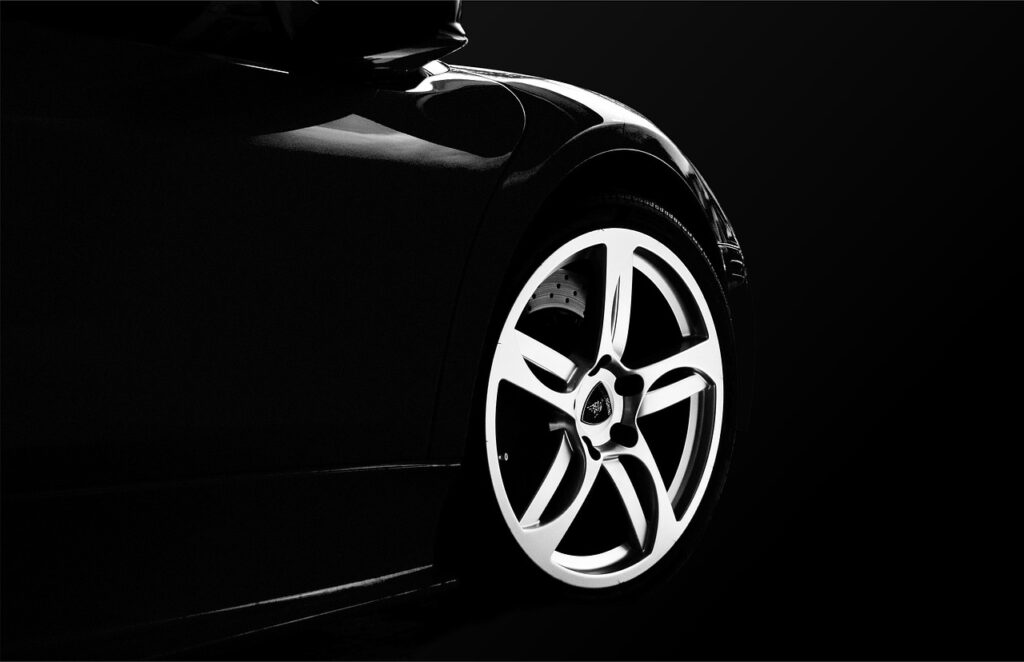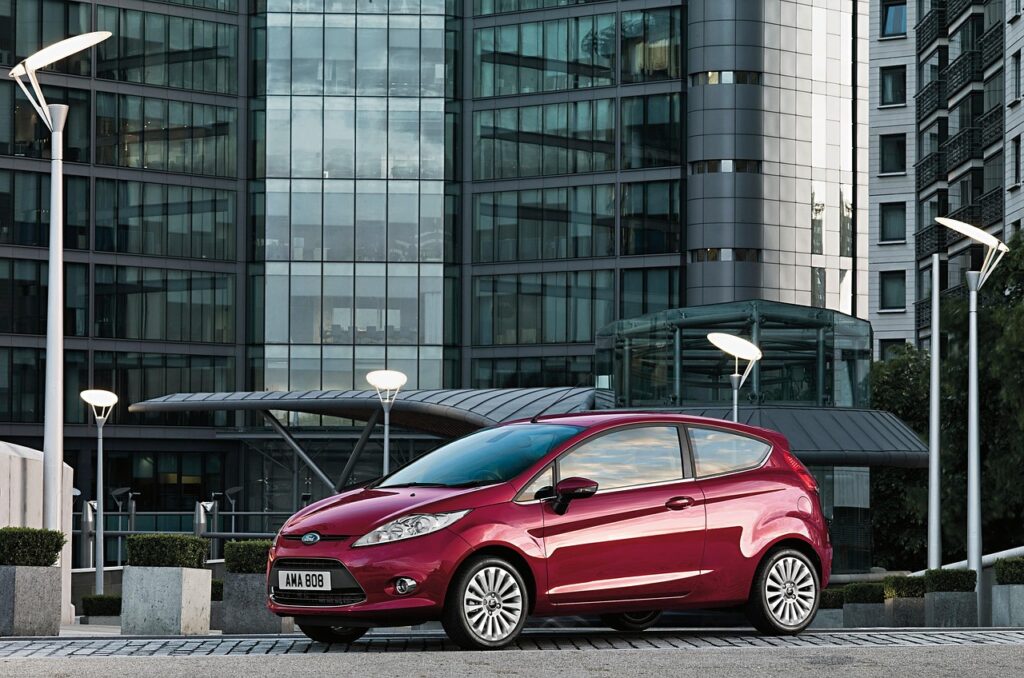For many automotive enthusiasts, the allure of a classic car is undeniable. There’s a romanticism in the lines of a vintage model, a tangible connection to a bygone era of engineering and design. The rumble of an old engine, the smell of aged leather, the sheer joy of piloting a machine with character – these are the sensations that drive collectors and dreamers alike to seek out a piece of automotive history. Yet, as any seasoned veteran of the classic car market will attest, not every vintage beauty is a smart buy, and the road to classic car ownership is often paved with more pitfalls than pleasure.
In an age where information is readily available, it’s easier than ever to research a classic’s pedigree. However, even with all the online tools at our disposal, from vehicle history reports to comparison sites, many classic car owners still find themselves regretting their purchase. The dream of restoring a forgotten gem can quickly turn into a financial nightmare, thanks to hidden issues, exorbitant repair costs, and a market that simply doesn’t value certain models as highly as their owners might hope. The hard truth is, some cars, despite their iconic status or initial promise, simply aren’t worth the emotional or financial investment.
This in-depth analysis, drawing on the insights of veteran mechanics and automotive experts, aims to pull back the curtain on those classic cars that consistently underperform, disappoint, or simply fail to hold their value. We’re not just talking about obscure failures; some models on this list might surprise you, especially if you, like many, once had a poster of them adorning your bedroom wall. Our mission is to provide a critical perspective, helping discerning collectors and enthusiasts make informed decisions and steer clear of models that promise more headaches than horsepower.
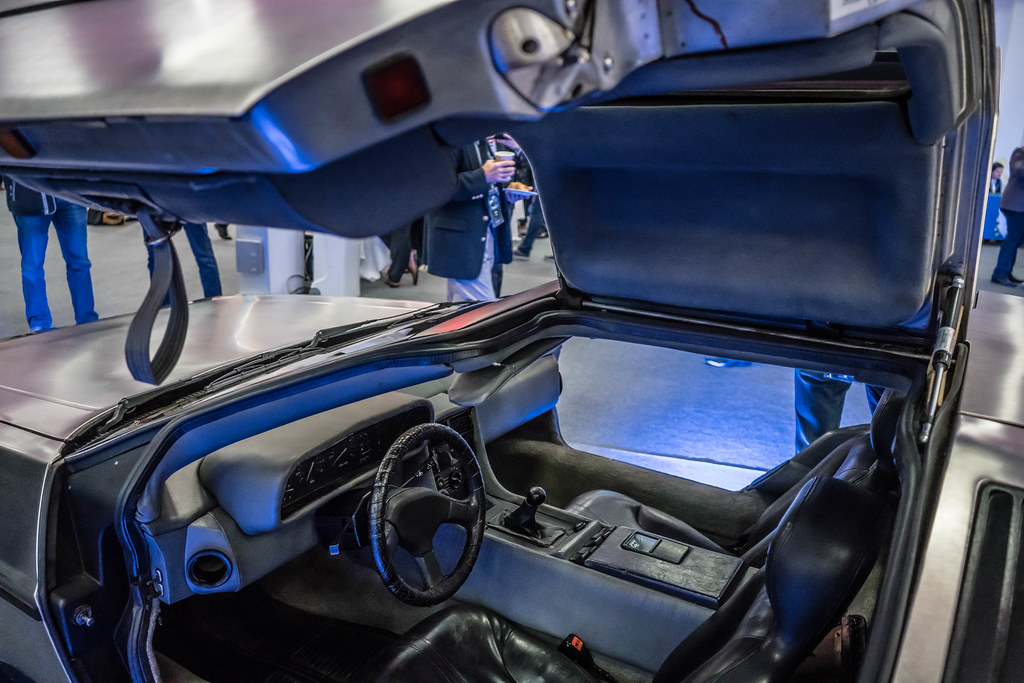
1. **DeLorean DMC-12**
The DeLorean DMC-12 is iconic, forever associated with “Back to the Future.” Its striking stainless steel body and gull-wing doors promised a futuristic driving experience, captivating a generation with its unique aesthetic. John DeLorean’s vision created an undeniable mystique, ensuring its instant recognition and endless fascination today. This unique visual appeal remains a powerful draw, making it a conversation starter wherever it goes.
However, this cinematic ideal sharply contrasts with mechanical reality. The DMC-12 was notoriously underpowered; its 2.85L V6 engine produced a mere 130 horsepower, inadequate even for its era and failing to deliver sports car performance. Furthermore, it suffered from spotty build quality and reliability issues. The specialized, expensive maintenance required for its stainless steel body added significantly to ownership costs, making repairs difficult and often impractical for the average enthusiast.
Veteran mechanic Chris Pyle notes the DMC-12’s “performance… did not match its extravagant looks.” While a desirable display piece, the actual driving experience and substantial maintenance demands lead to regret for many owners. Its high cost of ownership and fundamental mechanical shortcomings cement its status as a questionable investment, proving an iconic look doesn’t always translate into a worthwhile classic.
Car Model Information: 1982 Delorean DMC-12
Name: DMC DeLorean
Alt: 1982 DeLorean
Caption: 1982 DeLorean
Manufacturer: DeLorean Motor Company
Production: January 21, 1981 – December 1982
ModelYears: 1981–1983
Assembly: Dunmurry
Designer: Giorgetto Giugiaro
Class: Sports car
BodyStyle: coupé
Layout: Rear-engine, rear-wheel-drive layout
Doors: Gull-wing doors
Engine: 2.85 L
Abbr: on
Powerout: 130 hp
Transmission: 5-speed manual ,3-speed automatic
Wheelbase: 2413 mm
Length: 4267 mm
Width: 1988 mm
Height: 1140 mm
Weight: 1233 kg
Sp: us
Categories: 1980s cars, All Wikipedia articles written in American English, Articles with short description, Automobiles with backbone chassis, Automobiles with gull-wing doors
Summary: The DMC DeLorean is a rear-engine, two-seat sports car manufactured and marketed by John DeLorean’s DeLorean Motor Company (DMC) for the American market from 1981 until 1983—ultimately the only car brought to market by the fledgling company. The DeLorean is sometimes referred to by its internal DMC pre-production designation, DMC-12, although this was not used in sales or marketing materials for the production model. Designed by Giorgetto Giugiaro, the DeLorean is noted for its gull-wing doors and brushed stainless-steel outer body panels, as well as its lack of power and performance. Though its production was short-lived, the DeLorean became widely known after it was featured as the time machine in the Back to the Future films. With the first production car completed on January 21, 1981, the design incorporated numerous minor revisions to the hood, wheels and interior before production ended in late December 1982, shortly after DMC filed for bankruptcy and after total production reached an estimated 9,000 units. Despite the car having a reputation for poor build quality and an unsatisfactory driving experience, the DeLorean continues to have a strong following, driven in part by the popularity of Back to the Future. 6,500 DeLoreans were estimated to still be on the road as of 2015.
Get more information about: DMC DeLorean
Buying a high-performing used car >>>
Brand: DeLorean Model: DMC-12
Price: $129,950 Mileage: 3,145 mi.
Read more about: From Pontiac’s GT-37 ‘Holy Grail’ to Hemi Convertibles: Uncovering the Rarest Muscle Car Treasures You Never Knew Existed
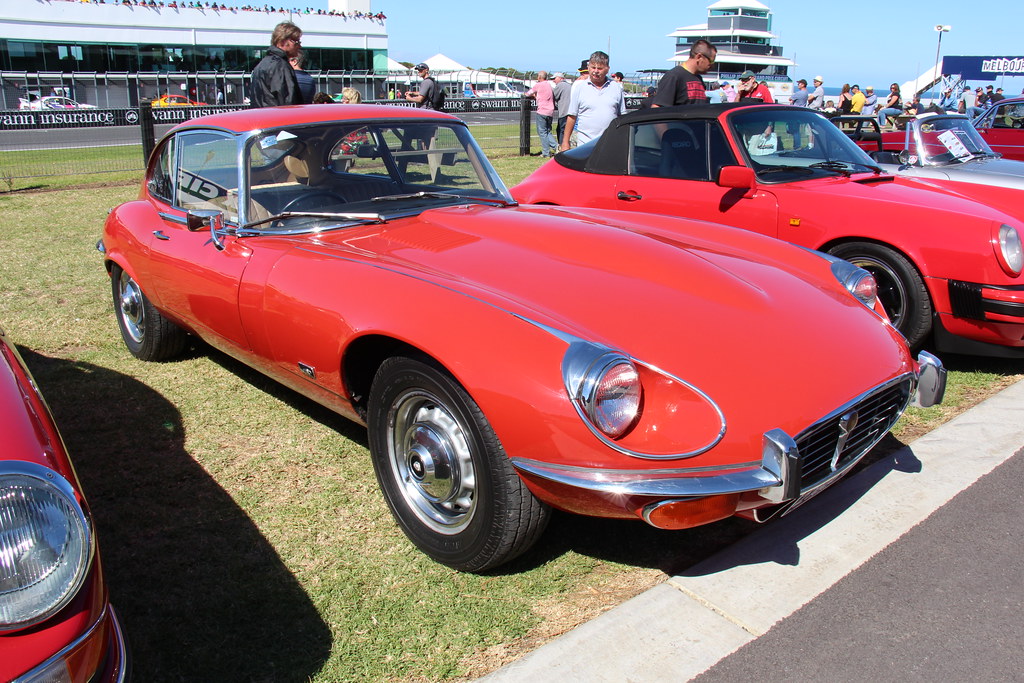
2. **Jaguar E-Type Series III**
The Jaguar E-Type, particularly in its earlier forms, is celebrated as a masterpiece of automotive design, embodying British elegance and sports car prowess. The Series III, introduced in 1971, continued this visual legacy, featuring a new 5.3-liter V12 engine and a longer wheelbase for a more grand touring feel. Its flowing lines and powerful stance retained much of the E-Type’s legendary charm, promising refined power and luxurious comfort, an enticing package for a discerning buyer.
However, the acclaimed V12 engine, despite its impressive displacement, quickly became synonymous with unreliability and high maintenance costs. Its complex design made it a nightmare to service, requiring specialized knowledge and frequent, expensive workshop visits. Finding parts for this intricate powerplant is also notoriously pricey, transforming routine upkeep and unexpected repairs into a considerable financial drain. For many, the initial allure of the V12’s smooth power was quickly overshadowed by persistent mechanical issues, eroding the joy of ownership.
Experts often caution enthusiasts that the Series III E-Type is “better admired at a distance than owned.” Unlike its more robust six-cylinder predecessors, the V12 model struggles to justify its ownership challenges with a commensurate return on investment or hassle-free enjoyment. Its reputation for expensive, complex, and frustrating maintenance means the financial and emotional toll often outweighs the aesthetic pleasure. Consequently, it falls short as a truly worthwhile classic investment for those prioritizing reliability and long-term value.
Car Model Information: 1972Jaguar E-Type Restomod
Sp: uk
Name: Jaguar E-Type
Caption: 1972 E-Type Series 1 3.8-Litre, the first production model of this open two-seater
Aka: Jaguar XK-E , Jaguar V-12
Manufacturer: Jaguar Cars
Production: 1961–1974
Class: Sports car
Predecessor: Jaguar XK150
Related: Jaguar D-Type,Jaguar XJ13
Successor: Jaguar XJS
Layout: FMR layout
Assembly: Coventry,England
Designer: Malcolm Sayer
Categories: 1970s cars, 2+2 coupés, All articles with dead external links, All articles with specifically marked weasel-worded phrases, All articles with unsourced statements
Summary: The Jaguar E-Type, or the Jaguar XK-E for the North American market, is a British front mid-engined sports car that was manufactured by Jaguar Cars Ltd from 1961 to 1974. Its sleek appearance, advanced technologies, high performance, and competitive pricing established it as an icon. The E-Type’s claimed 150 miles per hour (240 km/h) top speed, sub-7-second 0 to 60 mph (97 km/h) acceleration, largely unitary body construction, front and rear independent suspension with disc brakes, mounted inboard at the rear, and rack-and-pinion steering spurred industry-wide changes. The E-Type was based on Jaguar’s D-Type racing car, which had won the 24 Hours of Le Mans for three consecutive years beginning in 1955. The E-Type employed what was, for the early 1960s, a novel design principle, with a front subframe carrying the engine, front suspension and front bodywork bolted directly to the body tub. No ladder frame chassis, as was common at the time, was needed and as such the first cars weighed only 1,315 kg (2,899 lb). It is rumored that, on its debut on 15 March 1961, Enzo Ferrari called it “the most beautiful car ever made”, but this statement is not fully confirmed. In 2004, Sports Car International magazine placed the E-Type at number one on their list of Top Sports Cars of the 1960s. In March 2008, the Jaguar E-Type ranked first in The Daily Telegraph’s online list of the world’s “100 most beautiful cars” of all time.
Get more information about: Jaguar E-Type
Buying a high-performing used car >>>
Brand: Jaguar Model: E-Type
Price: $64,900 Mileage: 2,455 mi.
Read more about: Revving Up Nostalgia: 14 Vintage ’60s Cars That Are Now Every Collector’s Gold Mine for Enthusiasts

3. **Ford Mustang II (1974–1978)**
The Ford Mustang II represents a contentious chapter in the iconic pony car’s history, a response to the 1970s fuel crisis that drastically departed from its powerful predecessors. Launched between 1974 and 1978, it was conceived as a smaller, more fuel-efficient, and less powerful vehicle. This radical shift in philosophy, unfortunately, resulted in a design and performance package that largely failed to capture the essence of what made the Mustang a legend. It was an awkward compromise, aiming for practicality but missing the mark on soul.
Often labeled “the worst Mustang ever,” the Mustang II was plagued by weak engines and an uninspired design that struggled to find widespread appeal. Its standard 2.3L four-cylinder engine delivered a mere 88 horsepower, a stark contrast to the robust V8s associated with the Mustang name. This significant reduction in power, coupled with an overall awkward styling, meant it never truly resonated with enthusiasts or critics. It felt more like a rebadged economy car than a true heir to the Mustang legacy.
Veteran mechanic Chris Pyle critically points out that the Mustang II simply doesn’t “look that great and they are weak.” He highlights the common dilemma for owners: “You have to put a bigger motor in it, which kind of takes away the meaning of classic.” This observation underscores the car’s fundamental flaw for collectors, as significant modifications are often necessary to make it enjoyable, thereby compromising its originality. For those seeking a classic that offers both driving satisfaction and appreciation, the Mustang II consistently proves to be a regrettable investment, passed over by serious collectors.
Car Model Information: 1978 Ford Mustang II
Name: Ford Mustang II
Caption: Ford Mustang II coupe
Aka: Ford Mustang II , Ford T5 (in Germany)
Class: Pony car,Subcompact car
Production: 1973–1978
ModelYears: 1974–1978
Predecessor: Ford Mustang (first generation)
Successor: Ford Mustang (third generation)
Assembly: Unbulleted list
Layout: Front-engine, rear-wheel-drive layout
BodyStyle: coupé,hatchback
Related: Ford Pinto,Ford Pinto
Manufacturer: Ford Motor Company
Engine: ubl
Transmission: ubl
Wheelbase: cvt
Length: cvt
Width: cvt
Height: cvt
Designer: Buck Mook, Dick Nesbitt
Categories: All articles with dead external links, All articles with unsourced statements, Articles with dead external links from April 2024, Articles with permanently dead external links, Articles with short description
Summary: The second-generation Ford Mustang, marketed as the Ford Mustang II, is a two- or three-door, four-passenger, front-engine/rear-drive pony car manufactured and marketed by Ford from 1973 until 1978. Introduced in September 1973 for the 1974 model year, the Mustang II arrived roughly coincident with the oil embargo of 1973 and subsequent fuel shortages. Developed under Lee Iacocca, it was an “entirely new kind of pony car.” Ford “decided to call it Mustang II, since it was a new type of pony car designed for an era of high gas prices and fuel shortages.” The Mustang II was 490 lb (222 kg) lighter and almost 19 in (483 mm) shorter than the 1973 Mustang, and derived from the subcompact Pinto platform. While sharing a limited number of driveline components with the Pinto, the Mustang II employed an exclusive subframe, isolating its front suspension and engine mount subframe. The steering used a rack-and-pinion design. Named Motor Trend’s 1974 Car of the Year and reaching over 1.1 million sales over four years of production, the Mustang II is noted simultaneously for both its marketing prescience and strong sales – while criticized as having abandoned essential aspects of the Mustang heritage and described, in a retrospective after 40 years since its introduction, as embodying the Malaise era.
Get more information about: Ford Mustang (second generation)
Buying a high-performing used car >>>
Brand: Ford Model: Mustang II
Price: $25,919 Mileage: 49,076 mi.
Read more about: Hold My Beer: These 14 Cars Went From Automotive Icons to Total Cringe Fails and We’re Not Sorry
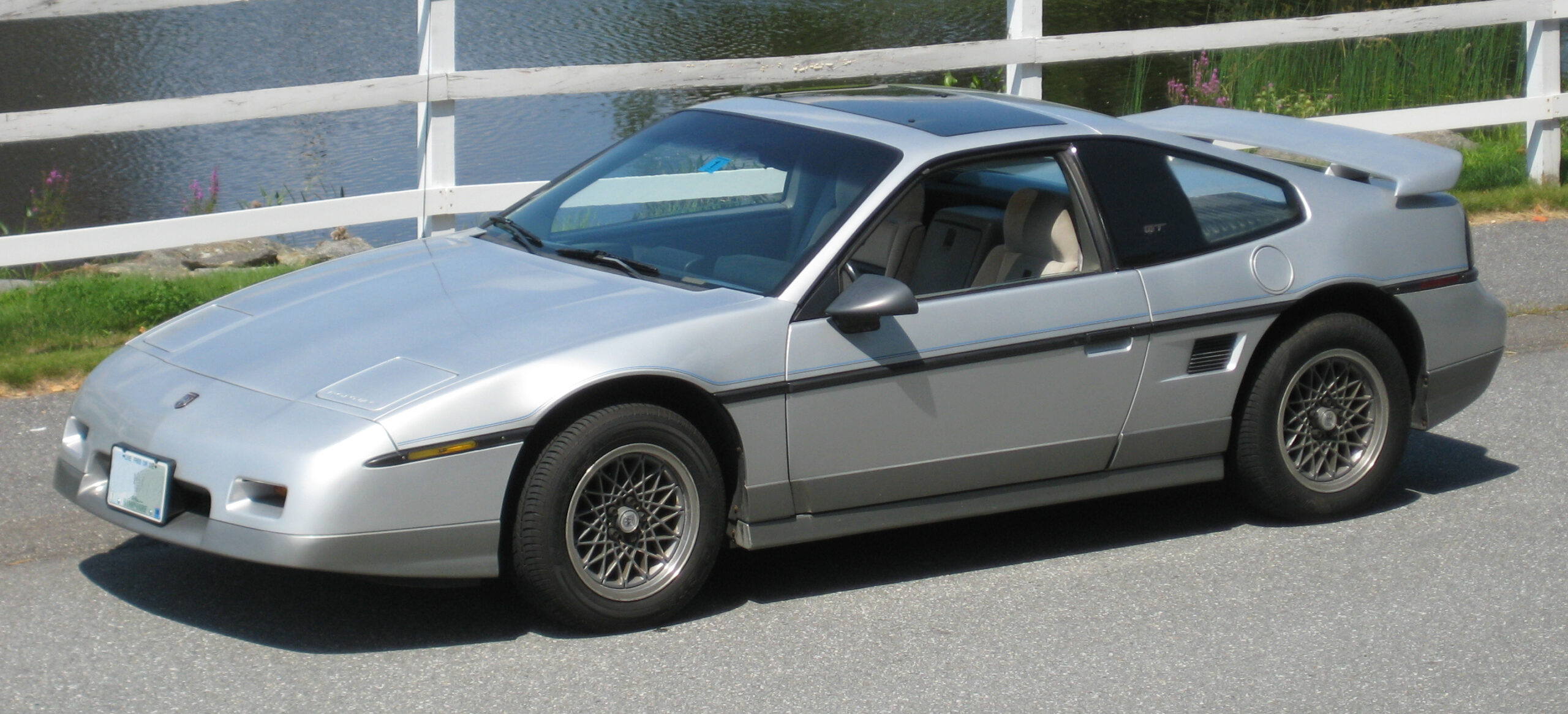
4. **Pontiac Fiero**
The Pontiac Fiero was a bold, albeit ultimately flawed, experiment by General Motors in the mid-1980s. It was designed as an affordable, mid-engine sports car, a radical concept for an American manufacturer aiming for a broader market. Its distinctive wedge-shaped profile and two-seater layout promised exciting dynamics and a fresh approach to accessible performance. This ambitious project aimed to put the thrill of exotic car layouts within reach of everyday enthusiasts, generating considerable initial excitement and anticipation.
However, the Fiero’s innovative design was quickly overshadowed by a series of severe reliability issues and a damaging reputation, particularly concerning engine fires. Early production models were notorious for poor build quality, leading to numerous mechanical failures that frustrated owners and tarnished the car’s image. These critical flaws were not just minor inconveniences; they fundamentally compromised the vehicle’s safety and trustworthiness, necessitating recalls and significant revisions throughout its short production run.
Chris Pyle, a veteran mechanic, offers a stark commentary on the Fiero’s performance, drawing a comparison between its engine and a lawnmower, emphasizing its “boring” driving experience. While acknowledging it as a “cool concept,” experts generally conclude that the Fiero is “rarely worth the hassle” for collectors. The burden of rectifying its notorious problems, coupled with its often underwhelming performance, makes it a questionable classic investment. Its legacy of trouble frequently overshadows its initial appeal.
Car Model Information: 1987 Pontiac Fiero SPORT GT
Name: Pontiac Fiero
Caption: 1987 Fiero Formula
Manufacturer: Pontiac (automobile)
Production: August 1983 – August 16, 1988,370,168 produced
ModelYears: 1984 – 1988
Successor: Pontiac Solstice
Assembly: Pontiac, Michigan
Designer: Hulki Aldikacti,George Milidrag
Class: Sports car
BodyStyle: fastback,notchback
Platform: GM P platform
Layout: Rear mid-engine, rear-wheel-drive layout
Engine: {{cvt,151,CID,L,1,disp=flip,Iron Duke engine#LR8,Inline-four engine
Transmission: Turbo-Hydramatic 125,Manual transmission,Getrag 282 transmission,Isuzu
Wheelbase: 2373 mm
Abbr: on
Length: 4072 mm
Width: 1750 mm
Height: 1191 mm
Weight: 1116 to
Categories: All articles with unsourced statements, Articles with short description, Articles with unsourced statements from February 2012, Articles with unsourced statements from July 2024, Articles with unsourced statements from September 2011
Summary: The Pontiac Fiero is a rear mid-engine, light sports car manufactured and marketed by Pontiac for model years 1984 – 1988. Intended as an economical commuter car with modest performance aspirations, it was Pontiac’s first two-seater since their 1926 to 1938 coupes, and the first mass-produced, rear mid-engine car by any American manufacturer. In addition to using 4- and 6-cylinder engines to help Pontiac meet America’s ‘CAFE’ average fuel economy requirements, the Fiero’s chassis and structure technology used non-load-bearing, composite body-panels, contributing to the car’s light-weight and its unique selling proposition. Pontiac engineers modified the design over its life to enhance its performance and reposition the two-seater closer to the implications of its sporty configuration. The Fiero 2M4 (two-seat, mid-engine, four-cylinder) placed on Car and Driver magazine’s Ten Best list for 1984, and was the Official Pace Car of the Indianapolis 500 for 1984. A total of 370,168 Fieros were manufactured over five years’ production, its mild performance, reliability and safety issues becoming points of criticism. The Fiero was discontinued after annual sales fell steadily.
Get more information about: Pontiac Fiero
Buying a high-performing used car >>>
Brand: Pontiac Model: Fiero
Price: $11,990 Mileage: 98,558 mi.
Read more about: 10 Iconic American Cars That Are Simply Too Dangerous for Today’s Roads
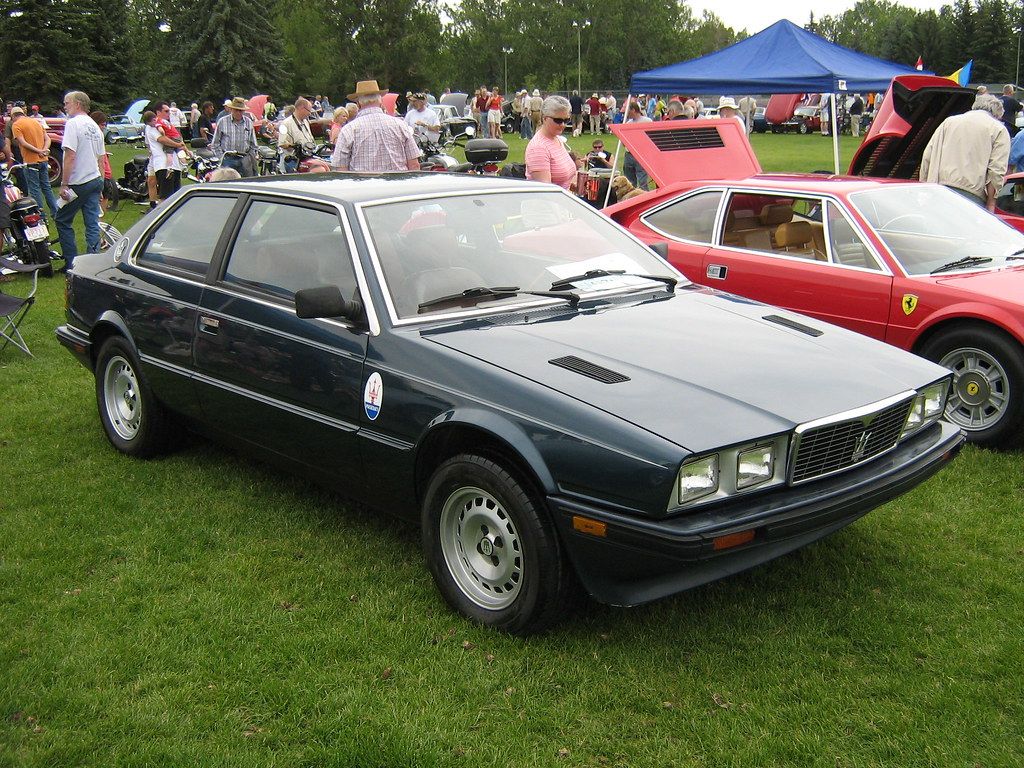
5. **Maserati Biturbo**
Maserati’s Biturbo, introduced in the early 1980s, represented an audacious attempt to democratize Italian luxury and performance. This compact model featured a pioneering twin-turbo V6 engine, aiming to deliver high-performance motoring and the prestige of the Trident badge at a more accessible price point. Its distinctive, angular styling was characteristic of the era, and on paper, it promised an enticing blend of exhilarating speed and Italian automotive artistry. The vision was to expand Maserati’s reach beyond its traditional, ultra-exclusive clientele.
However, the Biturbo’s advanced engine technology and complex systems proved to be its greatest vulnerability. Despite having “the badge and the boost,” it notoriously lacked reliability, quickly gaining a reputation for being fragile and prone to expensive mechanical failures. The intricate twin-turbo setup, coupled with inconsistent build quality, meant that exciting drives often culminated in frustrating and costly repair bills. This rapidly shattered the illusion of affordable exotic car ownership, as the true cost of maintenance became apparent.
Professional mechanic Stamatis Zotos explicitly advises staying “away from buying” the Maserati Biturbo (1982 to 1988), highlighting its persistent issues. This expert consensus underscores its status as a financial drain rather than a sound investment. The challenges of sourcing specialist parts and the high expenses associated with its upkeep make long-term ownership a daunting prospect. Even seasoned collectors largely avoid it today, a clear indicator that prestigious branding cannot overcome fundamental engineering flaws.
Car Model Information: 1984 Maserati Biturbo Base
Name: Maserati Biturbo
Caption: Maserati Biturbo E
Manufacturer: Maserati
Production: 1981–1994
Assembly: Modena,Rho, Lombardy
Related: Maserati Shamal,Maserati Ghibli#Ghibli (AM336),Maserati Barchetta,Maserati Quattroporte#Quattroporte IV,Maserati Karif
Designer: Pierangelo Andreani (1977),Marcello Gandini,Zagato
Class: Grand tourer
BodyStyle: 2+2 (car body style),coupé,sedan (car),Cabriolet (automobile)
Layout: Front-engine, rear-wheel-drive layout
Engine: twin-turbocharged,2.5 L twin-turbocharged 90° V6,2.8 L twin-turbocharged 90° V6
Transmission: ZF Friedrichshafen,Automatic transmission,ZF Friedrichshafen
Wheelbase: {{convert,2,514,mm,in,1,abbr=on
Length: {{convert,4,150,mm,in,1,abbr=on
Abbr: on (228)
Width: {{convert,1,710,mm,in,1,abbr=on
Height: {{convert,1,310,mm,in,1,abbr=on
Successor: Maserati Ghibli#Ghibli (AM336),Maserati Quattroporte#Quattroporte IV
Sp: uk
Categories: 1990s cars, All articles needing additional references, All articles with unsourced statements, Articles needing additional references from November 2019, Articles needing additional references from October 2010
Summary: The Maserati Biturbo is a family of executive grand tourers produced by Italian automobile manufacturer Maserati between 1981 and 1994. The original Biturbo was a two-door, four-seater notchback coupé (of somewhat smaller dimensions than the BMW 3 Series of the time) featuring, as the name implies, a two-litre V6 engine with two turbochargers and a luxurious interior. The car was designed by Pierangelo Andreani, Chief of Centro Stile Maserati up to 1981, somewhat influenced by the design of the then recent Quattroporte III (penned by Italdesign Giugiaro). All Maserati models introduced from the Biturbo’s inception in 1981, until 1997, were based on variants of the original Biturbo architecture, including the later grand tourers like the Shamal and Ghibli II, as well as the 1994 fourth generation Quattroporte, which used an evolved and slightly stretched (to 2.65 m / 104.3 in wheelbase) Biturbo Saloon platform. The Barchetta, while of a different layout entirely, used an ultimate version of the Biturbo V6 engine.
Get more information about: Maserati Biturbo
Buying a high-performing used car >>>
Brand: Maserati Model: Biturbo
Price: $13,899 Mileage: 18,319 mi.
Read more about: Illuminating Icons: A Deep Dive into 15 Classic Cars with the Most Jaw-Dropping Tail Light Designs

6. **Triumph TR7**
The Triumph TR7, launched in 1975, was heralded as “the shape of things to come,” signaling a modern departure for the British sports car manufacturer. Its distinctive wedge-shaped design aimed for a contemporary aesthetic, moving away from Triumph’s traditional, curvaceous roadsters. Designed to be affordable and practical, with a 2.0-liter engine, it sought to meet evolving safety and emissions standards, particularly for the North American market. The car was envisioned as a fresh, forward-thinking entry into the sports car segment.
Despite its modern aspirations, the TR7 quickly garnered a reputation for significant quality and reliability problems. Owners frequently reported persistent “electrical gremlins,” a common ailment of many British vehicles of the era but particularly prevalent and frustrating in the TR7. These chronic electrical issues, combined with widespread rust problems that compromised structural integrity, made the ownership experience far from enjoyable. The allure of its novel design quickly faded under the shadow of continuous mechanical and structural failures.
Performance of the TR7 was also widely regarded as underwhelming, failing to deliver the spirited driving dynamics expected of a sports car. This unfortunate combination of poor build quality, pervasive reliability concerns, and uninspiring performance meant the car struggled to establish itself as a truly desirable classic. The context explicitly labels it a “risky purchase” that hasn’t “earned the nostalgic love other British classics have.” For collectors, the TR7’s notorious history of issues significantly outweighs its unique visual appeal.
Car Model Information: 1975 Triumph TR7
Sp: uk
Name: Triumph TR7
Caption: 1975 Triumph TR7
Production: unbulleted list
Manufacturer: British Leyland Motor Corporation
Class: Sports car
Layout: FR layout
Predecessor: Triumph TR6
Transmission: unbulleted list
Related: Triumph TR8
Engine: unbulleted list
Abbr: on (coupé)
BodyStyle: unbulleted list
Wheelbase: 85 in
Length: 160 in
Width: 66.2 in
Weight: 1101 kg
Order: flip (coupé)
Height: 50 in
Assembly: unbulleted list
Designer: Harris Mann
Categories: 1980s cars, All articles with unsourced statements, Articles tagged with the inline citation overkill template from January 2024, Articles with short description, Articles with specifically marked weasel-worded phrases from January 2024
Summary: The Triumph TR7 is a sports car that was manufactured in the United Kingdom from September 1974 to October 1981 by British Leyland Motor Corporation (BLMC), which changed its name to British Leyland (BL) in 1975. The car was launched in the United States in January 1975, with its UK home market debut in May 1976. The UK launch was delayed at least twice because of high demand for the vehicle in the US, with final sales of new TR7s continuing into 1982. It was initially produced at the Speke, Liverpool, factory, moving to Canley, Coventry, in 1978 and then finally to the Rover Solihull plant in 1980.
Get more information about: Triumph TR7
Buying a high-performing used car >>>
Brand: Triumph Model: TR7
Price: $12,500 Mileage: 83,693 mi.
Read more about: The Costly Truth: 14 Classic Cars That Are Simply Not Worth Restoring for the Savvy Enthusiast
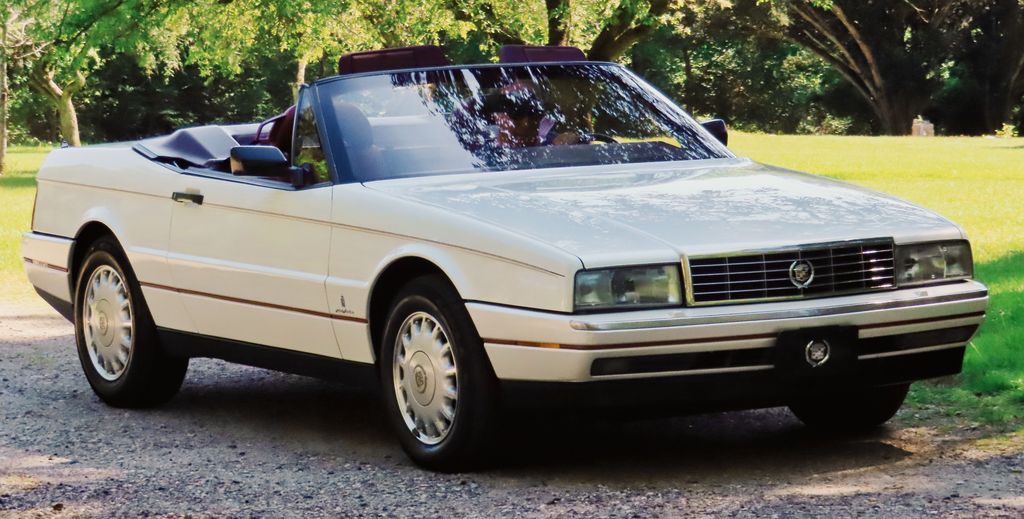
7. **Cadillac Allanté**
The Cadillac Allanté, introduced in the late 1980s, was an ambitious and unique attempt by General Motors to challenge European luxury roadsters directly. Its most distinctive feature was a collaborative manufacturing process: Pininfarina in Italy designed and built the bodies, which were then airlifted to Detroit in custom 747s for final assembly. This unprecedented “air bridge” aimed to blend American luxury with Italian craftsmanship, creating an exclusive and aspirational image for Cadillac’s new flagship convertible. The project underscored Cadillac’s desire to reclaim a top-tier position.
However, the Allanté’s grand ambitions were undermined by a significant disparity between its high price tag and its actual performance. While visually appealing, the Cadillac chassis and powertrain often failed to deliver the exhilarating dynamics or the refined driving experience expected from a vehicle competing in the premium segment. This crucial disconnect, coupled with serious quality control issues, hampered its market acceptance. The inherent complexities of its unique assembly process likely contributed to these inconsistencies, frustrating both buyers and the brand.
Compounding its problems, the Allanté was notorious for “skyrocketing maintenance costs,” a factor that quickly deterred potential buyers and existing owners. These high costs, combined with strong competition from established luxury brands, led to dismal sales figures, and the model was swiftly retired after just a few years. Consequently, the Allanté “aged without charm or value,” becoming more of a “curiosity than collectible.” It offers little return for the substantial investment required for its upkeep, serving as a cautionary tale of overambition not matched by execution.
Beyond the initial seven examples, our journey into the often-misleading world of classic cars continues. It’s crucial for enthusiasts and collectors to look past the superficial appeal and delve into the hard facts about reliability, performance, and long-term value. Some vehicles, despite their initial fanfare or nostalgic presence, simply don’t hold up to the scrutiny of seasoned automotive experts. They often promise an experience they simply cannot deliver, leaving owners with significant financial and emotional burdens.
This next collection of vehicles further exemplifies the adage that not every vintage beauty is a smart buy. We’ll continue to pull back the curtain on models that, for various compelling reasons—from fundamental design flaws to chronic mechanical woes and disappointing market performance—are consistently highlighted by experts as ones to avoid. For those passionate about preserving automotive history, making informed decisions means understanding which classics offer a genuine return on investment and driving pleasure, and which are merely captivating curiosities.
Read more about: The Road Less Traveled (and Valued): 14 Classic Cars That Are Now Worth Less Than You Think

8. **Chevrolet Corvette C4 (1984–1996)**
The Chevrolet Corvette C4 certainly turned heads when it debuted, a striking statement of American sports car ambition for its era. Its sleek, aerodynamic lines and distinctive digital dashboard offered a compelling vision of modernity, pushing the boundaries of what a Corvette could be. Enthusiasts were drawn to its aggressive stance and the promise of exhilarating performance, embodying the spirit of a new generation of American muscle.
However, the passage of time has not been kind to many C4 Corvettes. A common complaint among experts is the interior, which often features “cheap plastics” that have not aged gracefully, detracting significantly from the driving experience. Furthermore, while impressive for its day, the C4’s performance is often described as “mediocre by today’s standards,” falling short of the dynamic benchmarks set by more contemporary sports cars.
Adding to these issues, the C4 has seen “limited appreciation in value,” effectively pushing it off the radar of serious collectors seeking an appreciating asset. Unlike earlier, more revered Corvette generations, the C4 often struggles to command strong prices in the secondary market, making it a questionable investment for those focused on resale potential. In essence, while it bears the iconic Corvette name, the C4 has largely become a classic in name only, offering more nostalgia than genuine collector appeal.
Car Model Information: 1996 Buick Envision Preferred
Name: Chevrolet Corvette (C4)
Caption: 1996 Chevrolet Corvette
Manufacturer: Chevrolet
Production: January 3, 1983 – June 20, 1996
ModelYears: 1984–1996
Predecessor: Chevrolet Corvette (C3)
Successor: Chevrolet Corvette (C5)
Class: Sports car
Assembly: Bowling Green, Kentucky
BodyStyle: targa top,Convertible (car)
Layout: Front-engine, rear-wheel-drive layout#FMR
Platform: GM Y platform
Wheelbase: cvt
Length: cvt
Width: cvt
Height: Coupe: {{cvt,46.7,in,mm
Transmission: automatic transmission,Overdrive (mechanics),GM 4L60-E transmission,ZF Friedrichshafen
Engine: {{cvt,350,cuin,L,1,Chevrolet small-block engine (first- and second-generation)#L83
Weight: cvt
Designer: Jerry Palmer
Related: Callaway Cars#C4 (RPO B2K Callaway Twin Turbo Corvette),Callaway Cars#C4 (RPO B2K Callaway Twin Turbo Corvette),Callaway Cars#C4 (RPO B2K Callaway Twin Turbo Corvette),Callaway Cars#C6 (Callaway SuperNatural Corvette),Callaway Cars#C4 (RPO B2K Callaway Twin Turbo Corvette)
Categories: 1990s cars, All articles with dead external links, All articles with unsourced statements, Articles with dead external links from November 2016, Articles with permanently dead external links
Summary: The Chevrolet Corvette (C4) is the fourth generation of the Corvette sports car, produced by American automobile manufacturer Chevrolet from 1983 until 1996. The convertible returned, as did higher performance engines, exemplified by the 375 hp (280 kW) LT5 found in the ZR1. In early March 1990, the ZR1 would set new records for the highest average speed over 24 hours at over 175 mph (282 km/h) and highest average speed over 5,000 miles at over 173 mph (278 km/h). With a completely new chassis, modern sleeker styling, and other improvements to the model, prices rose and sales declined. The last C4 was produced on June 20, 1996.
Get more information about: Chevrolet Corvette (C4)
Buying a high-performing used car >>>
Brand: Chevrolet Model: Corvette C4
Price: $20,221 Mileage: 46,554 mi.
Read more about: The Costly Truth: 14 Classic Cars That Are Simply Not Worth Restoring for the Savvy Enthusiast
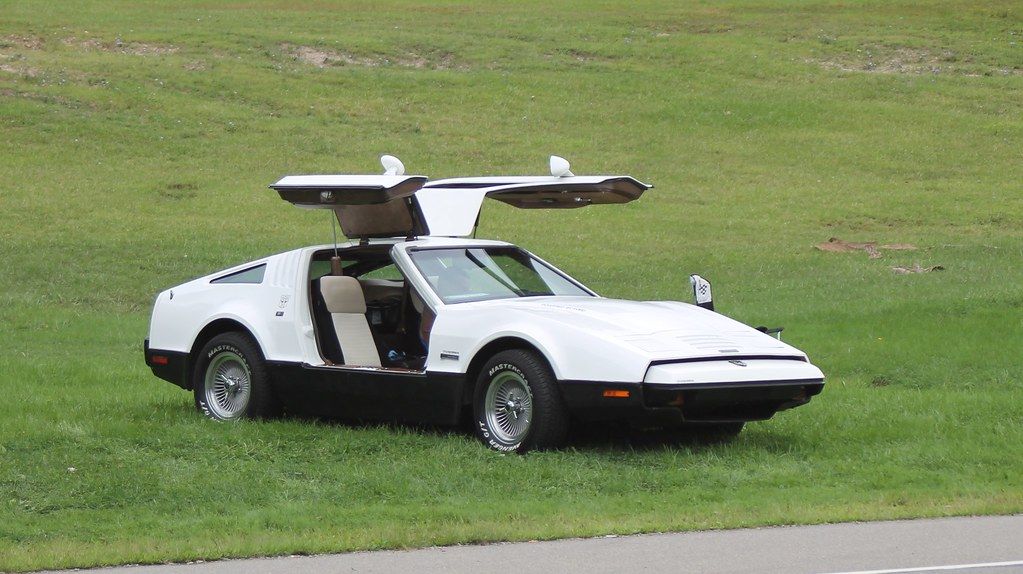
9. **Bricklin SV-1**
The Bricklin SV-1, a truly unique Canadian creation, arrived on the scene with ambitious promises of futuristic safety and striking gull-wing doors. Conceived in the mid-1970s, it aimed to blend high-performance motoring with a commitment to driver and passenger protection, a bold vision for a car of its time. Its distinctive wedge shape and hydraulic gull-wing doors certainly made it an instant conversation starter, standing out dramatically from its contemporaries.
However, the SV-1’s innovative spirit was ultimately overshadowed by a host of critical manufacturing and operational problems. It was notoriously “plagued by quality issues” from the outset, leading to frequent mechanical breakdowns and significant owner frustration. The complex hydraulic system for its signature doors, for instance, often proved temperamental and unreliable, adding to the car’s reputation for being difficult to live with.
Further compounding its woes, the Bricklin SV-1 suffered from “limited production” numbers, which while sometimes beneficial for rarity, often translates to a scarcity of parts and specialized knowledge for repairs. This makes maintenance a significant headache and an expensive endeavor for owners. Ultimately, the SV-1 became “more of a cautionary tale than a collector’s dream,” a fascinating footnote in automotive history that serves as a stark reminder that innovation without execution can lead to a financially draining, rather than rewarding, classic car experience.
Car Model Information: 1975 Bricklin SV-1
Name: Bricklin SV-1
Manufacturer: Bricklin Canada Ltd.,General Vehicles Inc.
Production: 1974–1976
ModelYears: 1974–1976
Assembly: Saint John, New Brunswick
Designer: Marshall Hobart,Herb Grasse
Class: Sports car
BodyStyle: hatchback
Layout: Front-engine, rear-wheel-drive layout
Engine: ubl ,AMC V8 engine#360
Transmission: ubl
Wheelbase: cvt
Length: cvt
Width: cvt
Height: cvt
Weight: cvt
Sp: us
Doors: Gull-wing doors
Categories: Articles with short description, Automobiles with gull-wing doors, CS1: long volume value, Cars introduced in 1974, Cars of Canada
Summary: The Bricklin SV-1 is a two-seat sports car produced by American businessman Malcolm Bricklin and his manufacturing company from 1974 until early 1976. The car was noteworthy for its gull-wing doors and composite bodywork of color-impregnated acrylic resin bonded to fiberglass. Assembly took place in Saint John, New Brunswick, Canada. The name SV-1 is an abbreviation of “safety vehicle one”. Bricklin company literature uses both the SV-1 and SV1 formats. To promote the car’s safety bona fides, the company touted such features as its integrated roll-over structure and energy-absorbing bumpers.
Get more information about: Bricklin SV-1
Buying a high-performing used car >>>
Brand: Bricklin Model: SV-1
Price: $36,485 Mileage: 34,002 mi.
Read more about: The Costly Truth: 14 Classic Cars That Are Simply Not Worth Restoring for the Savvy Enthusiast
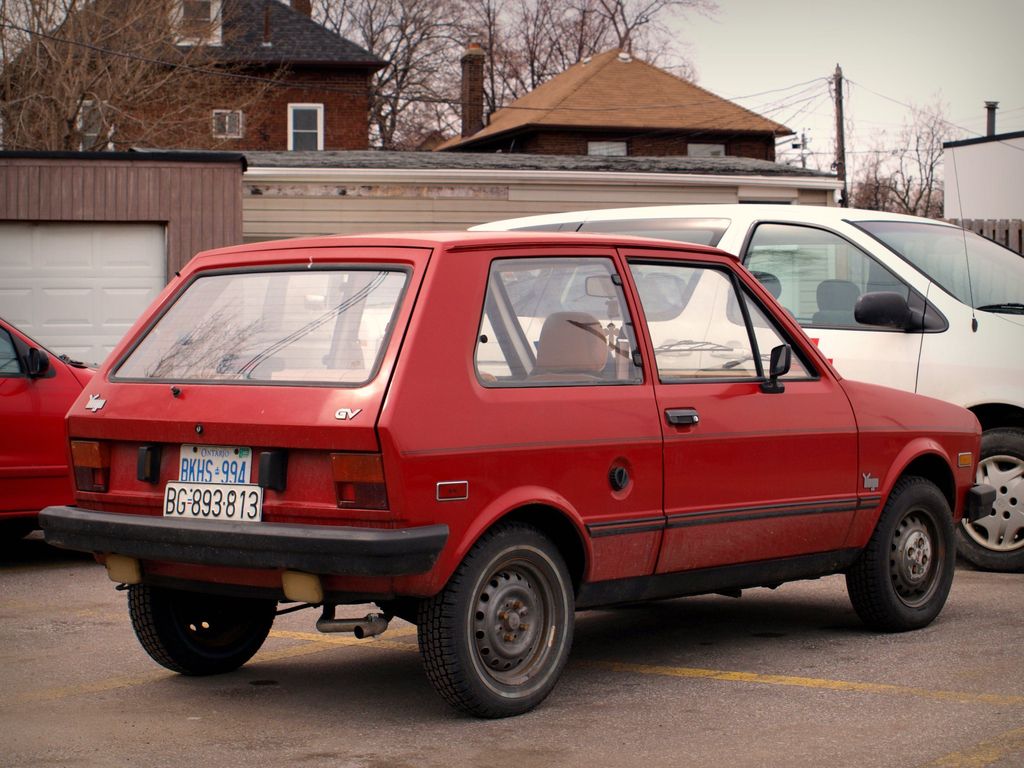
10. **Yugo GV**
The Yugo GV burst onto the American automotive scene in the 1980s with one primary distinction: it was the cheapest car available. This humble hatchback, imported from Yugoslavia, was positioned as an ultra-affordable option for budget-conscious buyers, prioritizing basic transportation above all else. Its low price tag was its main selling point, offering a new car experience at a cost traditionally associated with used vehicles.
Predictably, the Yugo’s affordability came at a steep price in terms of quality and reliability. It quickly gained a notorious reputation for “terrible reliability and laughable build quality,” becoming synonymous with mechanical failures and shoddy construction. Owners often found themselves contending with a litany of issues, from electrical gremlins to persistent engine problems, transforming daily driving into an exercise in patience and frequent trips to the mechanic.
Today, the Yugo GV holds a unique, if unflattering, place in automotive lore, widely regarded as “a running joke among car lovers.” Its legacy is defined by its consistent underperformance and lack of durability, rather than any enduring positive attributes. Consequently, “nobody collects one unless it’s for irony,” highlighting its profound lack of genuine collector appeal. For those seeking a classic that offers long-term satisfaction or investment potential, the Yugo GV stands as a stark warning of what happens when cost-cutting supersedes quality.
Read more about: Consumer Alert: 15 Vehicles Mechanics Say You Must Avoid for Reliable, Worry-Free Driving
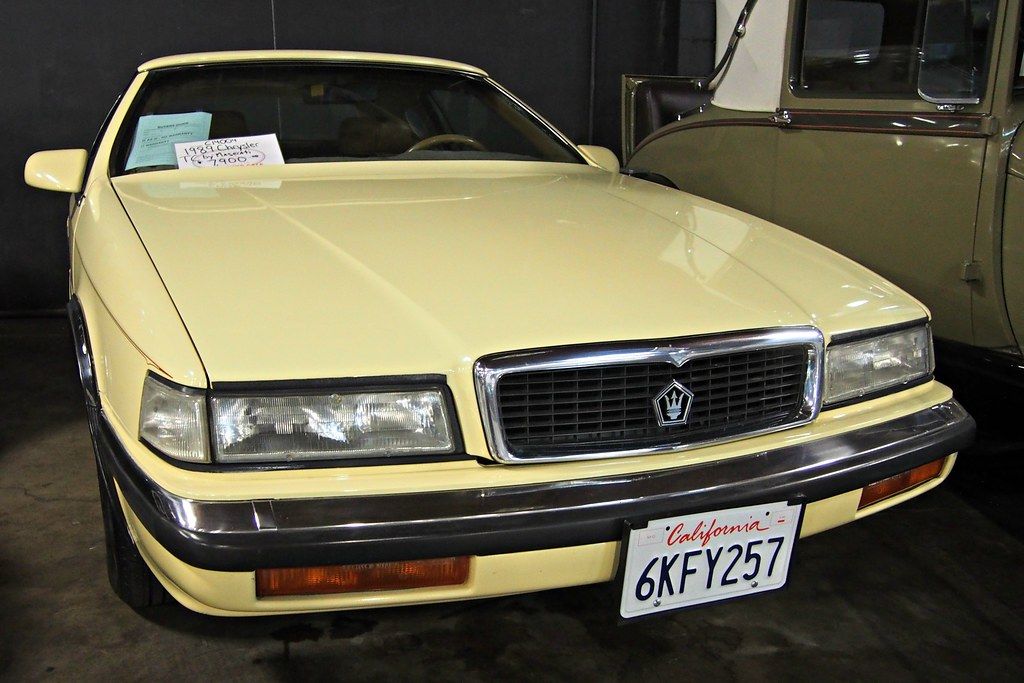
11. **Chrysler TC by Maserati**
The Chrysler TC by Maserati represented an ambitious, if ultimately ill-fated, attempt to blend American luxury with Italian flair. Introduced in 1989, this convertible was the product of a transatlantic collaboration, aiming to create a premium, limited-edition grand tourer that would rival European roadsters. Its design showcased a distinctive blend of styles, attempting to capture an exclusive niche in the luxury market with a prestigious badge.
However, the TC suffered from “confused branding” and a fundamental identity crisis. Buyers struggled to justify paying a premium, often described as a “Maserati price,” for a car that, beneath its distinctive exterior, shared many components with more humble Chrysler models. This perception of rebadging, rather than true bespoke Italian engineering, significantly hampered its market acceptance and led to dismal sales figures throughout its short production run.
Furthermore, the TC delivered “mediocre performance” that failed to impress against established luxury competitors, leaving buyers feeling underwhelmed by its driving dynamics. Compounded by “high maintenance costs” and the inherent complexities of its joint development, the car quickly plummeted in value after its debut. Today, the Chrysler TC by Maserati “offers little in return for collectors,” serving as a cautionary tale of a luxury collaboration that tried to be too many things to too many people, ultimately failing to capture a lasting appeal or significant appreciation.
Car Model Information: 1989 Buick Envision Preferred
Name: Chrysler TC by Maserati
Manufacturer: Maserati,Chrysler (division)
Production: 1988–1990
ModelYears: 1989–1991
Class: Grand tourer
Layout: Front-engine, front-wheel-drive layout
Predecessor: Imperial (automobile)#Sixth generation (1981–1983)
Successor: Chrysler Crossfire
Platform: Chrysler Q platform
BodyStyle: convertible
Engine: Chrysler 2.2 & 2.5 engine#Turbo II,Chrysler 2.2 & 2.5 engine#TC,Mitsubishi 6G7 engine#6G72
Transmission: manual transmission,TorqueFlite,Ultradrive
Weight: 3033 lb
Abbr: on
Wheelbase: 93.3 in
Length: 175.8 in
Width: 68.5 in
Height: 51.9 in
Assembly: Torino,Sparone,Milan
Categories: 1990s cars, All articles with unsourced statements, Articles with short description, Articles with unsourced statements from August 2025, Articles with unsourced statements from March 2021
Summary: The Chrysler TC by Maserati is a two-passenger, two-door convertible jointly developed by Chrysler and Maserati. Introduced at the 1986 Los Angeles Auto Show., the TC was positioned as a grand tourer using a “Q” body on a modified second-generation Chrysler K platform. After two years of development delays, the TC became available in late-1988 and a total of 7,300 units (the minimum required under the contract) were manufactured in Milan, Italy, through 1990. All cars sold as 1991 models were manufactured in 1990.
Get more information about: Chrysler TC by Maserati
Buying a high-performing used car >>>
Brand: Chrysler Model: TC by Maserati
Price: $20,221 Mileage: 46,554 mi.
Read more about: Beyond the Mainstream: 15 Wild Classic Car Features Automakers Left in the Dust and Why You Won’t See Them Again

12. **Ford Thunderbird (1989–1997)**
The Ford Thunderbird, a nameplate synonymous with American automotive style and personal luxury for decades, underwent a significant transformation with its ninth and tenth generations, spanning from 1989 to 1997. While earlier iterations are celebrated as iconic designs, these later models represented a notable departure, moving towards a more contemporary, aerodynamic aesthetic that aimed for broader appeal in a competitive market. The redesigned models sought to keep pace with evolving tastes, adopting a smoother, more rounded silhouette.
Yet, for many enthusiasts and collectors, these later T-Bird models had fundamentally “lost their identity.” The distinctive flair and commanding presence of previous generations were replaced by “bland styling” that struggled to stand out in a crowded segment. This lack of visual distinctiveness, coupled with “uninspired performance,” left a significant portion of the automotive community underwhelmed. The driving experience, while comfortable, rarely delivered the excitement or character expected from a car bearing the Thunderbird name.
As a direct result of this perceived dilution of its heritage and a lack of compelling attributes, these T-Birds simply “don’t spark much interest” among collectors today. Unlike their more revered predecessors that command significant attention and value, the 1989-1997 models often languish on the sidelines of the classic car market. They stand as an example of how a once-legendary nameplate can lose its way, becoming a less desirable classic for those seeking genuine automotive pedigree and investment potential.
Car Model Information: 1989 Ford Thunderbird
Name: Ford Thunderbird
Caption: 1989 Thunderbird
Manufacturer: Ford Motor Company
Production: unbulleted list
ModelYears: unbulleted list
Class: unbulleted list
Layout: Front-engine, rear-wheel drive layout
Categories: 1960s cars, 1970s cars, 1980s cars, 1990s cars, 2000s cars
Summary: The Ford Thunderbird is a personal luxury car manufactured and marketed by Ford Motor Company for model years 1955 to 2005, with a hiatus from 1998 to 2001. Ultimately gaining a broadly used colloquial nickname, the T-Bird, the model was introduced as a two-seat convertible, subsequently offered variously in a host of body styles including as a four-seat hardtop coupe, four-seat convertible, five-seat convertible and hardtop, four-door pillared hardtop sedan, six-passenger hardtop coupe, and five-passenger pillared coupe, before returning in its final generation, again as a two-seat convertible. At its inception, Ford targeted the two-seat Thunderbird as an upscale model. The 1958 model year design introduced a rear seat and arguably marked the expansion of a market segment that came to be known as personal luxury cars, positioned to emphasize comfort and convenience over handling and high-speed performance.
Get more information about: Ford Thunderbird
Buying a high-performing used car >>>
Brand: Ford Model: Thunderbird
Price: $14,500 Mileage: 49,430 mi.
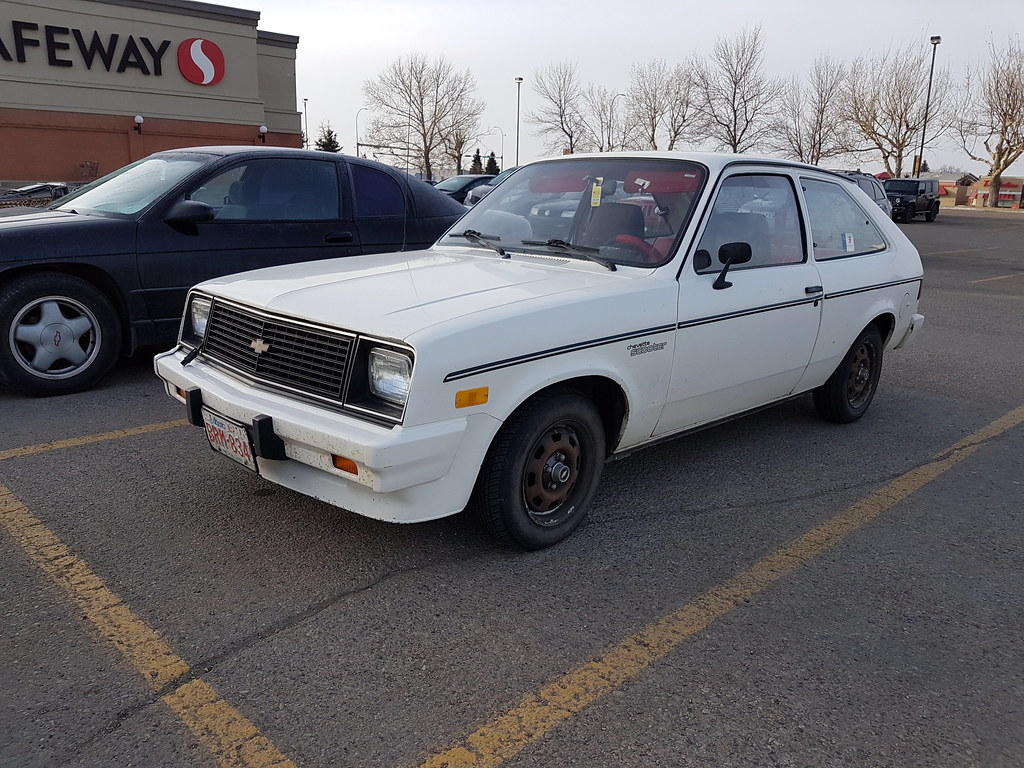
13. **Chevrolet Chevette**
The Chevrolet Chevette holds a distinct place in automotive history as a prime example of a cheap and practical economy car, embodying the spirit of no-frills transportation. Introduced in the late 1970s, it was designed specifically to be an affordable, fuel-efficient, and compact vehicle, perfectly suited for the challenging economic climate of its time. The Chevette delivered on its promise of basic mobility, becoming a common sight on American roads as a dependable, albeit unexciting, daily driver.
Crucially, the Chevette was “never meant to inspire excitement.” Its utilitarian design, modest performance figures, and sparse interior appointments firmly placed it in the realm of functional transportation rather than aspirational ownership. There was little about the car that stirred the soul or hinted at future classic status; it simply served its purpose as an accessible and economical option for the masses, a workhorse rather than a show pony.
Consequently, “time hasn’t changed that” perception for collectors. While some economy cars from the era have developed a quirky, underdog appeal, the Chevette has largely remained what it always was: an uncollectible, basic vehicle. Its lack of inherent charm, performance, or significant historical innovation means that, despite its prevalence in its day, the Chevrolet Chevette consistently ranks low on the list for classic car enthusiasts looking for an investment or a vehicle with appreciating value.
Read more about: Remember These? 17 Cars That Went From Cool to Cringe
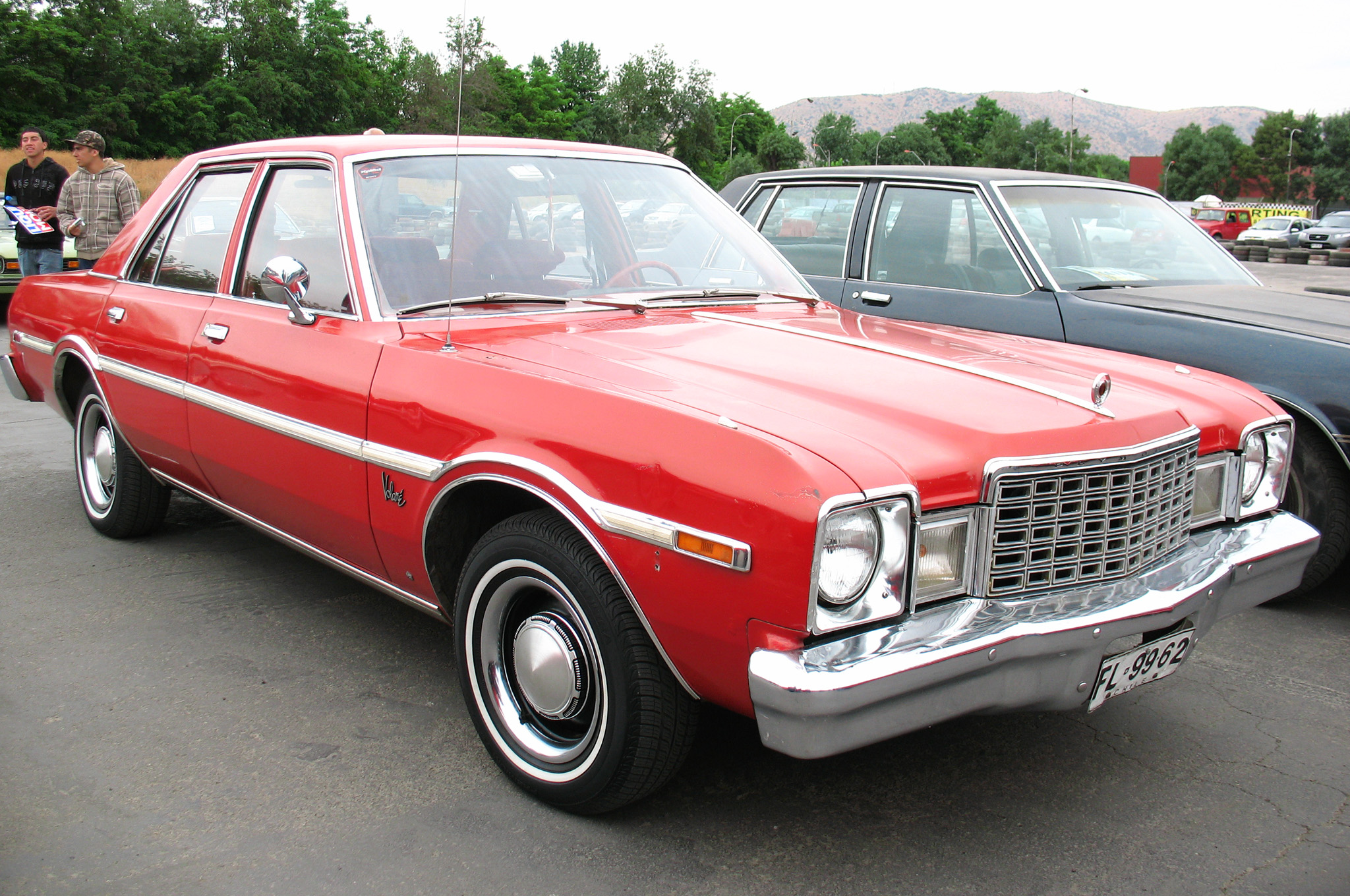
14. **Dodge Aspen/Plymouth Volaré**
The Dodge Aspen and Plymouth Volaré twins were introduced in the mid-1970s as Chrysler’s entries into the compact/intermediate car market, intended to be stylish family cars that offered a blend of practicality and contemporary design. They were positioned as successors to popular models like the Dart and Valiant, aiming to provide a fresh, modern aesthetic with improved comfort and features for the average American family. Their initial reception was positive, promising a new era for Chrysler in this crucial segment.
However, this initial promise quickly unraveled as both the Aspen and Volaré became “known for rust, recalls, and a slew of mechanical issues.” Early models were particularly plagued by widespread quality control problems that manifested as persistent reliability concerns, frustrating owners and severely damaging their reputation. Rust often appeared prematurely, compromising the vehicle’s structural integrity and aesthetic appeal, while numerous recalls further highlighted design and manufacturing shortcomings.
For many, the ownership experience quickly devolved into a series of headaches and costly repairs, transforming the stylish family car into a source of constant vexation. As a result, the legacy of the Dodge Aspen and Plymouth Volaré today is “more lemon than legend.” They stand as stark reminders that good intentions and contemporary styling are insufficient without robust engineering and consistent quality. These models consistently fail to generate significant collector interest, offering little return for the potential investment and ongoing maintenance required.
Car Model Information: 1977 Dodge Aspen
Caption: Dodge Aspen coupe
Name: Plymouth Volaré / Dodge Aspen
Manufacturer: Chrysler
Production: 1976–1980
ModelYears: 1976–1980
Class: Compact car
Layout: Front-engine, rear-wheel-drive layout
Platform: Chrysler F platform
Assembly: Hamtramck, Michigan
BodyStyle: station wagon,sedan (car),coupe
Engine: {{convert,225,CID,L,1,abbr=on,Chrysler Slant-6 engine
Abbr: on (wagon)
Transmission: manual transmission,TorqueFlite,A998/A999 3-speed TorqueFlite automatic,manual transmission
Predecessor: Plymouth Valiant
Successor: Plymouth Reliant,Dodge 400
Aka: ubl
Wheelbase: {{convert,108.7,in,mm,0,abbr=on
Weight: 3200 lb
Length: {{convert,198.8,in,mm,0,abbr=on
Width: 73.3 in
Height: {{convert,53.3,in,mm,0,abbr=on
Related: Monteverdi Sierra
Categories: All articles needing additional references, All articles with unsourced statements, Articles needing additional references from June 2025, Articles with short description, Articles with unsourced statements from December 2008
Summary: The Dodge Aspen, and its badge engineered variant, the Plymouth Volaré, are compact rear-drive cars manufactured and marketed by Chrysler for model years 1976-1980 in four-door sedan, two-door coupe, and four-door wagon styles. During the Volaré/Aspen’s production, North American automakers were actively “downsizing” their lineups, reducing size and weight for improved fuel economy — and the industry was reclassifying its size nomenclature. The Volaré/Aspen were thus classified originally as compact cars and as intermediate-sized cars by the time their production ended. The Volaré/Aspen were discontinued following the 1980 model year prior to the introduction of the front-wheel-drive Plymouth Reliant and Dodge Aries, known collectively as K-cars. The end of production also marked the demise of Dodge Main Assembly, which was closed the same day.
Get more information about: Dodge Aspen
Buying a high-performing used car >>>
Brand: Dodge Model: Aspen
Price: $12,500 Mileage: 68,590 mi.
As we conclude this deep dive into classic cars that haven’t quite lived up to the hype, it becomes abundantly clear that the world of vintage automobiles is a nuanced landscape. The allure of a classic is potent, promising a tangible connection to history and an unparalleled driving experience. Yet, the path to fulfilling that dream is fraught with choices that demand more than just emotion. Discerning collectors and enthusiastic newcomers alike must arm themselves with knowledge, separating the true automotive treasures from those that, despite their storied past or iconic looks, ultimately deliver more headaches than horsepower. The goal isn’t to diminish the charm of any classic, but to empower you with the insights needed to make a truly informed decision, ensuring your journey into classic car ownership is one of joy, not regret. Remember, some classics are better admired in photographs than parked in your garage, draining your wallet. Drive smart, collect wisely.” “_words_section2”: “1997


